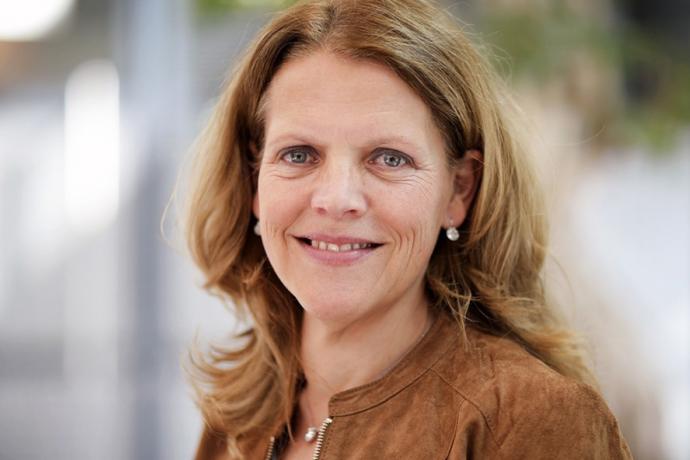She's a Scientist With One of the World's Most Important Jobs: Creating a Potential COVID-19 Vaccine
By Hanneke Schuitemaker, Ph.D., as told to Liz Ozaist, Global Content Lab Editor-in-Chief, Johnson & Johnson
Published 05-18-20
Submitted by Johnson & Johnson

Originally published by jnj.com
She has spent her career investigating some of the world's most pervasive infectious diseases—HIV and Ebola, just to name a couple—and now Hanneke Schuitemaker, Ph.D., is fighting a virus that could very well define her career.
As the Global Head of Viral Vaccine Discovery and Translational Medicine and the Disease Area Stronghold Leader for Viral Vaccines at Janssen Vaccines & Prevention, a Janssen Pharmaceutical Company of Johnson & Johnson, Schuitemaker and her team are tasked with researching, testing and producing a potential vaccine for Covid-19, a novel coronavirus that has infected millions worldwide since it was first identified in December 2019.
We sat down with Schuitemaker, who is based in Leiden the Netherlands, to talk about the crucial research work her team is doing, what stands out for her about the behavior of this novel coronavirus (hint: it likes to proofread) and what we can all learn about this historic pandemic that goes beyond the boundaries of science.
As Schuitemaker says, "I really hope we will learn lessons from this period, not only from a virological point of view, but also in terms of how we choose to live our lives."
Hanneke Schuitemaker, Ph.D.: Nothing could have prepared me for what we’re going through now. I've spoken about the threat of pandemics for some time—everything that could happen as a result of global warming, mosquitoes finding new habitats closer to human populations, the impact of the increased mobility of people—but I seriously had not thought through what it would actually be like to experience what we're experiencing now. The last pandemic of the same magnitude happened over 100 years ago—the 1918 Spanish flu pandemic—and most people who lived through it aren't with us today to share what it was really like.
But when I look at it purely from a scientific point of view and how to respond to Covid-19, I think we are doing the right thing with trying to limit its spread through social-distancing measures. We have some terrific learnings about this approach from the recent Ebola outbreak and how people in West Africa dealt with it, which is truly admirable. They were asked to quarantine, to adhere to frequent hand washing, to change their funeral habits, to change many of their daily rituals—and they did it. That helped to not only get the outbreak under control, but we also saw that other infectious diseases were strongly reduced during that time.
So I think we should really take these people as examples for us—that if we change our behavior, it can have an impact on slowing down the outbreak. Rather than see these measures as a nuisance, we should think of them as a necessity for humanity.
With a New Challenge Comes New Learnings
Of course, a global pandemic is different from an outbreak that's isolated to one region of the world. The current pandemic reminds me of what it was like to be a scientist when the first cases of AIDS were surfacing in the early 1980s. People were so scared of getting it, and that worry is reminiscent for me of what is happening with this novel coronavirus. And similar to the early days of the HIV crisis, there are still unknowns with this virus, which also makes it scary for people.​
But, as a scientist, I can say that we are learning things every day, and we are using that knowledge to help guide us in finding potential treatments and in fine-tuning vaccine development. For example, while certain other outbreaks may have been too small or localized to really start noticing trends, with Covid-19, we are seeing that age, gender (it seems to be impacting men at higher rates) and body mass index appear to be common risk factors for severe illness.
We could soon learn other things too. I recently had genetic testing done on my personal genome and learned that I have a somewhat increased susceptibility to SARS, which is another type of coronavirus. So the fact that we already have this kind of information about potential risk factors is a good thing, because it means we may be able to someday screen people who are predisposed to more severe Covid-19, which can then help with some of the scary unknowns—like why some young people without key risk factors are getting sick with Covid-19.
As a mother of three, I can't help but think about this. My youngest son was on a video chat with some friends the other day and they came up with a term for babies born during this time. He said to me, "These will always be the 'coronials.'" It’s true. There’s the pre- and post-coronavirus crisis—and the rules will never be the same.
A Virus with Special Editing Skills—and How a Vaccine Could Work to Thwart It
It's why my contributions as a viral vaccine scientist are even more important today. Beyond the science, the work that researchers are doing is about a greater purpose.
I recently met with the Prime Minister of the Netherlands, where I live, and I repeated to him something that I've said lately: "Treatments save lives, but vaccines save populations." When you get a vaccine, it's not just for yourself—it helps ensure that the transmission chain stops with you, and that helps keep your loved ones safe and healthy.
I've worked with a lot of viruses throughout my career and what's interesting about this novel coronavirus, known as SARS-CoV-2, is its ability to "proofread." Essentially, what this means is that if it makes a mistake in its replication of genetic material, there is a small thing running behind it that corrects the mistake. In other words, the virus is mutating at a slower rate, which helps scientists who are working on a potential vaccine.
With HIV, for instance, we say it’s a “sloppy virus,” but it’s smart sloppiness—it is constantly mutating and not proofreading. The fact that it makes so many mistakes is actually a big advantage for the virus, because it enables it to escape immune responses and also antiviral monotherapy. With Covid-19, if the virus is not changing, then the immune response elicited by a vaccine will fit with the virus that's circulating.
This has influenced our approach to a potential vaccine, which is built from an inactivated common cold virus that's not replicating. We are taking this approach in the development of our HIV, RSV, Zika and Ebola vaccines—and now our Covid-19 vaccine. So the outside of our vaccine always looks the same—the common cold virus Adeno 26—but inside, we have different transgenes coding for proteins of the virus against which we are making a vaccine. This helps create a vaccine with a known safety profile.
In nature, nothing is for nothing, which is why I am so interested in looking at this novel coronavirus also from an evolutionary point of view. Why is it proofreading? In theory, that would make it more vulnerable to a host's immunity, so maybe we will see years from now that it could become more like a common cold virus, which is what makes my work so intriguing.
A Pandemic and the Change It Brings
I really hope we will learn lessons from this period, not only from a virological point of view, but also in terms of how we choose to live our lives.
The director of the airport here in the Netherlands was making a statement recently about going back to normal, and he said we should also see this as an opportunity for change. It may seem obvious, but I for one, think it's an opportunity to care more for each other.
My middle son had just bought a house and was going to move out when this happened, and he was so worried about the situation. I wanted him to be able to go to his new house, but I also saw how tough it was on him. As a mother, you want to protect and sit on your eggs, even when your kids are grownups.
But this will pass, and the good that you can do for your kids in the meantime is to be there for them, to take away their sorrows, to take away their anxiety, to try and make some good memories now too—and that is priceless. We have large Zoom meetings—up to 50 people at a time—and I just love seeing people with kids on their laps, waving at the camera, while we are working on this vaccine.
I am also seeing things from a new perspective for myself. During the lockdown, I have been working from my home office, which has enabled me to notice the small things now that I so much appreciate—taking my dog out for morning walks, going out together again for long evening strolls, hearing the birds singing. I love it. Knowing that we are working on a vaccine, that we could be part of a solution, also feels good.

Johnson & Johnson
Johnson & Johnson
Caring for the world, one person at a time... inspires and unites the people of Johnson & Johnson. This year, we celebrate 126 years of embracing research and science – bringing innovative ideas, products and services to advance the health and well-being of people. Employees of the Johnson & Johnson Family of Companies work in more than 250 operating companies in 60 countries throughout the world. The passion and commitment of our people yield innovations that further minimize our impact on the planet, drive new alliances to address major health challenges in developing and developed countries, and help to create economic opportunity for people. Improving human health and well-being is our crucial mission and the ultimate measure of upholding our responsibility now and for generations to come.

At Johnson & Johnson, our top priority is health-health of people and the planet. That's why we set aggressive corporate wide goals to reduce our environmental impact, outlined in our Healthy Future 2015 goals. To this end, we established the proprietary Earthwards® process for developing and marketing greener products through lifecycle analysis. Every Earthwards® recognized product must achieve a greater than 10 percent improvement in at least three of the seven goal areas:
- Materials used
- Packaging reduction
- Energy reduction
- Waste reduction
- Water reduction
- Positive social impact or benefit
- Product innovation

More from Johnson & Johnson

